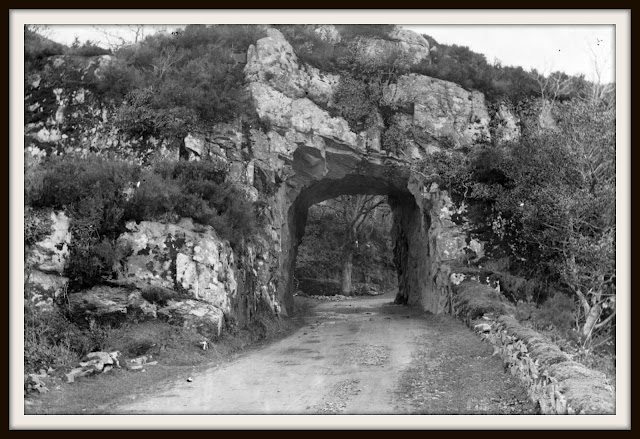 |
| Main Steet Kenmare 1880 |
 |
| Church and convent of the Holy Cross in Kenmare Opened in 1861 and consecrated in 1864. Closed in 1990, it has since been demolished. |
 |
| The original Kenmare House |
The original Kenmare House was built in 1726, and designed by Viscount Kenmare himself. The house was two stories high and had dormered attics with steep slated roofs. There were thirteen bays infront of the house, with three bays on each side of the center breaking forward. A servant's wing was added around 1775. The house, grounds, and gardens were much praised by visiting writers of the area.
During the visit of Queen Victoria to Kenmare House in August 1861, legend has it that she chose the site of Killarney House, a vast Victorian-Tudor mansion, which was the successor to Kenmare House. Kenmare House was demolised in 1872. The succeeding house was accidentally destroyed by fire in 1913 and never rebuilt.
 |
| Suspension Bridge, Kenmare 1841 |
The Suspension Bridge in Kenmare, Co. Kerry was located across Kenmare Sound and replaced a ferry service. The construction took approximately one year and was completed in 1841. The effects of heavy traffic damaged the bridge over time. Under traffic, the bridge deck sagged and rose in an alarming manner and gave the impression of being in danger of imminent collapse. Early in 1932 the bridge was declared unsafe and closed to traffic, and demolition followed.
 |
| Ardtully House in Kilgarvan, Co. Kerry 1847 The Ardtully House was constructed in 1847 by Sir Richard Orpen, a Dublin based solicitor whose family had connections to the Pettys, later Petty-Fitzmaurices and ultimately Marquesses of Lansdowne. As a result Orpen's ancestors was able to acquire their own substantial landholdings including the area around Ardtully in South Kerry amounting to 12,000 acres by the time of his death. The Ardtully House was built on the site of the old Ardtully castle which was finally destroyed by Cromwell during the civil wars. |
 |
| Ruins of the Ardtully House The inside of the house appears to have contained the usual collection of reception and bedrooms ranged over two storeys, the roofline marked by a succession of stepped gables and dormers. A substantial range of service outbuildings lay to the north. The Ardtully House was burnt in 1921 by the Irish Republican Army and has remained a ruin ever since. |
 |
| The front door of the Ardtully House |
 |
| The ruins of Killowen church on Kilgarvan Road |
 |
| The mail cart crossing Brickeen Bridge in Co. Kerry 1865 |
 |
| Blackwater Bridge in Kenmare |
 |
| Kenmare Tunnel |
Life in the rural communities of Ireland during the 1800s
 |
| A Kerry family in the wake of the Potato Famine 1845 |
 |
| Add caption |
 |
| Kate Kearney's Cottage at the Gap of Dunloe in Killarney Co. Kerry |
 |
| Mountain Stage near Drom in the Kingdom of Kerry An image of poverty, destitution and sheer misery that makes one cringe. Cringe for the people who had to live in such terrible conditions. Hard times affected people all over Ireland. |
 |
| Down on the old bog road The cataloguer at The National Library of Ireland believed these people were leaning on a rick of turf but the general consensus is this is a picture of their home. People living on the bog with a straight road leading off to the distant hills. |
 |
| Pack mules outside a home |
 |
| Quirks Cottage |
 |
| Cooperage in Killarney, Co. Kerry |
 |
| A farm laborer's turf hut |
 |
| Add caption |
 |
| Carrying Turf |
 |
| Bringing home the turf |
 |
| Carts carrying turf |
 |
| Add caption |








